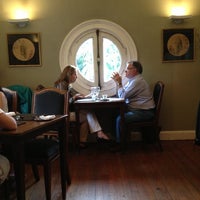

The color of the walls is in harmony with the golden and pale tones of the walls of the Regency Room. As far as design is concerned, the selection of sober Louis XVI style has proved fundamental. The Winter Garden: creates a beautiful connection between the dining-room and the ball room. The baroque atmosphere was accomplished by the combination of marble from Carrara in Italy and from the French Central Massif. It was inspired by the Versalles Palace and specially its Hercules Room was the chosen model.

The Dining-room: This luxurious room was planned bearing in mind the frequent dinners and social events offered by Mr Matías Errázuriz and Mrs.
MUSEO DECORATIVO BUENOS AIRES RUSSIAN COLLECTION WINDOWS
High windows with colored glass, the decoration of the ceiling, the imposing fireplace and the walls covered with tapestry and wood evoke the great English halls of the 16th century Tudor style. The floor consists of parquetry with a design of stars combining maple and walnut wood. The ceiling is decorated with caissons and patterned glass above: a hidden structure of big iron entablature to support five big chandeliers. The Great Hall (Renaissance): It is the biggest apartment of the residence and the only one with double height and an axis around which all the activities of the house took place. This is a room that connects with four other rooms and the area of the stairs and the lift. Above the cornice are allegories of the Arts: Music, Architecture, Sculpture and Painting which emphasize the Neoclassic character of the rooms.Īntechamber: Decorated in a Neoclassic mode, the Louis XV style is evident in the wooden panels: polished oak with frames and carvings, the ceiling – with central lighting – is decorated with plaster frames. Its sumptuous Louis XV style was accomplished including in its decoration Ionic pilasters, arcs and groin vault ceilings. The luxurious stairs lead to the principal floor.

The Entrance Hall: The walls and the ceiling are completely covered by fake Paris stone. The gardens and the neighboring Argentine Automobile Association On the top floor, in the attic were the rooms of the servants with the windows hidden by a balustrade. Gigantic Corinthian columns in the façade cover the two most important levels: the principal floor with round arches leading to the garden and terrace and the first floor where the family rooms were installed. The building has four levels visible from the external façade: on the basement, the windows of the cellars. Gabriel, architect in the Court of Louis XV. Its imposing and sober façade takes from the French Neo-classicism of the 18th century, especially from the works of Jacques A. The materials were brought from Europe: wooden panels, mirrors, marble, woodworks, frames, latches a number of European artisans were called for some of the stucco decorations. Carlhian worked the rooms the gardens were the responsibility of the French expert Achille Duchêne. Sergent's team was a group of selected decorators specialized in interior-decoration and gardens. The project of the building, a sample of pure eclecticism, was designed by the French architect René Sergent in 1911 but it was finished in 1917 due to the difficulties caused by the First World War.

Under Law 12351 the Argentine state bought the residence and the art collections which gave birth to the Museo Nacional de Arte Decorativo on 18 December 1937. The National Museum of Decorative Arts was established in 1937. Errazúriz died in 1935, however, the widower bequeathed the mansion to the Argentine government, on his son's and daughter's advice. Completed in 1916, the couple devoted the following two years to decorating the palace, purchasing a large volume of antiques and other objets d'art. The ornate Neoclassical structure inspired the Bosch family to commission a similar palace nearby (today the United States Ambassador's residence). The couple commissioned French architect René Sergent in 1911 to design a mansion for Errazúriz's future retirement from the diplomatic corps, in which he had been Ambassador to France for a number of years. The museum has its origins in a marriage in 1897 between two prominent members of turn-of-the-century Argentine high society: Matías Errazúriz, the son of Chilean émigrés, and Josefina de Alvear, the granddaughter of Independence-era leader Carlos María de Alvear. The National Museum of Decorative Arts is an art museum in Recoleta, Buenos Aires, Argentina.


 0 kommentar(er)
0 kommentar(er)
